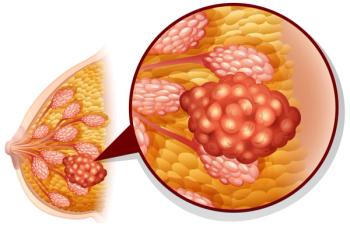
Neoadjuvant Durvalumab Plus Stereotactic Body Radiotherapy Yields High Major Pathological Responses in Non-Small Cell Lung Cancer
Patients with non–small cell lung cancer who were treated with durvalumab plus stereotactic body radiotherapy were found to have a major pathological response and was well tolerated among the population.
Neoadjuvant durvalumab (Imfinzi) plus stereotactic body radiotherapy has been found to elicit a major pathological response rate for patients with non-small cell lung cancer (NSCLC), according to the findings of a phase 2 study (NCT02904954) published in Lancet Oncology.
Findings from the study indicated that 53.3% of patients in the durvalumab plus radiotherapy group (n = 16; 95% CI, 34.3-71.7) had a major pathological response, of whom 8 achieved a complete pathological response (50%; OR 16.0; 95% CI, 3.2-79.6; P< .0001). Patients who did not undergo surgery did not have a major pathological response. In this group, 8 patients with adenocarcinoma (44%) and 8 with squamous cell carcinoma (66%) had a major pathological response. In both groups, patients were either current or former smokers. Additionally, 2 patients within the durvalumab monotherapy cohort achieved a massive pathological response (6.7%; 95% CI, 0.8-22.1).
“In this population of patients with operable clinical stages I–IIIA NSCLC, the preoperative combination of immune checkpoint blockade and radiotherapy to the primary tumor resulted in a significant and clinically meaningful increase in the proportion of patients with a major or complete pathological response,” the investigators of the study wrote.
Patients who enrolled on the study were randomly assigned to receive either durvalumab monotherapy (n = 30) or durvalumab plus radiotherapy (n = 30). In the intent-to-treat population (ITT), each group, 26 (87%) of patients underwent surgical resection.
In the durvalumab monotherapy group, 26 patients underwent the planned surgical resection, while 4 did not undergo resection due to death, the wishes of 1 patient, and 2 patients had disease progression. In the durvalumab plus radiotherapy group, 26 patients had surgery resection, while several did not due to preoperative death (n = 4) and disease progression (n = 3).
The primary end point of the trial was difference in major pathological response defined as 10% or fewer of viable tumor cells in the primary tumor between both groups. The secondary end point was 2-year disease-free survival for the entire cohort.
Across both groups, no patients had a complete radiographic response. In the single agent durvalumab group, 1 (3.3%) patient (95% CI, 0.1-17.2) and 14 (46.7%) patients in the durvalumab plus radiotherapy (95% CI, 28.3-65.7; P=.001) had a partial radiographic response. Among those who had a major pathologic response, 1 patient had a radiographically stable disease and 1 had a partial response in the durvalumab monotherapy group. Of those in the durvalumab plus radiotherapy group who had a major pathologic response, 11 had major or complete pathological response, and 5 had radiographic stable disease.
The median time from date of first cycle of durvalumab to surgical resection was 5.3 weeks in the durvalumab monotherapy group and 5.1 weeks in the durvalumab plus radiotherapy group. Additionally, the median time to surgery from the second treatment cycle was 2.4 and 2.1 weeks in the durvalumab and durvalumab plus radiotherapy groups, respectively.
The median follow-up time was 16.9 months (95% CI, 8.3-27.7), and 7 patients had disease recurrence in both groups following an R0 resection. In the durvalumab monotherapy group, 3 patients received R2 resection, 1 with pleural dissemination died of disease progression, and 2 who received adjuvant conformal radiotherapy remain disease free at 29 months and 5 months postoperatively.
Seventeen percent of those durvalumab monotherapy group had adverse effects (AEs) of grade 3/4 in of patient’s vs 20% of patients in the durvalumab plus radiotherapy group. The most frequent grade 3/4 AEs in both groups were hyponatremia and hyperlipasaemia. In 2 patients, serious AEs occurred that were related to treatment, including fatigue, adrenal insufficiency, pancreatitis, hyponatremia, and decreased platelet count. In each group, 1 patient died while waiting for surgical resection, which was considered unrelated to preoperative therapy. No treatment related deaths or deaths within 30 days post-surgery were reported.
“In contrast to prevailing strategies, combining immunotherapy with stereotactic body radiotherapy might be associated with a more favorable safety profile and higher patient compliance than is currently reported using combinations with full-dose chemotherapy or chemoradiation,” the investigators concluded.
Reference:
Altorki NK, McGraw TE, Borczuk AC, et al. Neoadjuvant durvalumab with or without stereotactic body radiotherapy in patients with early-stage non-small-cell lung cancer: a single-centre, randomised phase 2 trial. Lancet Oncol. 2021;22(6):824-835. doi:10.1016/S1470-2045(21)00149-2
Newsletter
Stay up to date on recent advances in the multidisciplinary approach to cancer.





















































































